Uluru Full Moon (english version)
“Uluru Full Moon”: This is a travel story that summarizes part of the adventure of a twelve years old boy: a Franco-Aboriginal child born in Reunion Island, on this land of multiculturalism where he grew up until the age of eight. After returning to Les Vosges in the land of his maternal family, and finding his father in epic circumstances, after having tragically lost him, he leaves with his mother to the antipodes of Oceania, to meet his biological family, on “Mother Earth”.
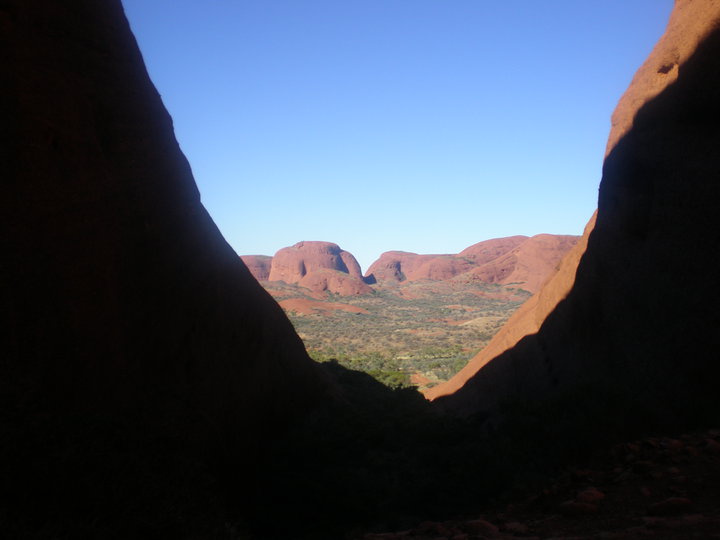
“Full Moon” is the full moon. Uluru is the famous rock that the British colonists called “Ayers Rock”. If it is emblematic it is far from being the only sacred place for the natives, in this country named “Sacred Land” or “Mother Land” by its first inhabitants who, like all the First Peoples[fr], mark a primordial respect and a mystical attachment to their “Mother Earth”. This monumental sandstone inselberg is located in the Northern Territories, in the center of the main island of Australia. It rises 348 meters above the red sand plain among many deserts. The ban on climbing is a fundamental taboo in the Aboriginal culture, which until 2016 has been violated in spite of a sham official agreement, and it is a financial windfall among others. In the height of hypocrisy, during this first trip in 2010 we saw the sign installed by the tour operator at the foot of the big rock, which expressly asked not to climb it, and in the background, on the big rock, like countless ants, naive, indifferent or unconscious climbing tourists. Back in Queensland, we saw the stupor mixed with despair of Uncle Barry (great uncle of Youva and Madi) when we told him about this sad situation. “They climb!!!!”
To say that the devastating fires in Australia, which are destroying millions of hectares of forest and carbonizing its animals, would be better contained with the science of the Aboriginal people, who know this land well and are its first occupants. (Reporterre, January 16, 2020 interview with Barbara Glowczewski[fr])
To say that last May, exactly ten years after our great journey, an aboriginal ancestral site was destroyed with dynamite in the west of the country, in order to expand an iron mine. On September 11th, we learn not without emotion the resignation of the French boss of Rio Tinto. (article by Jean-Claude Bourbon La Croix of September 11th, 2020[fr])
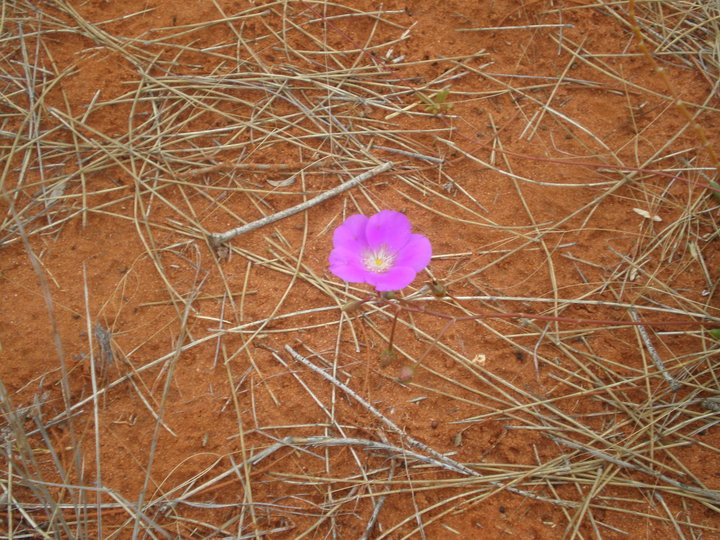
Today some languages are taught by indigenous academics thanks to a patient work of identity reconstruction, as many dialects have totally disappeared along with their related traditions. Some aboriginal words appear in the text as the trace of a highly spiritual civilization, annihilated by the greed, ignorance and ethnocentrism of the colonizers who, on arriving on the island continent, declared it Terra Nullius in 1770 by the act of Captain Cook, considering from a legal point of view its inhabitants as non-existent. Mpg
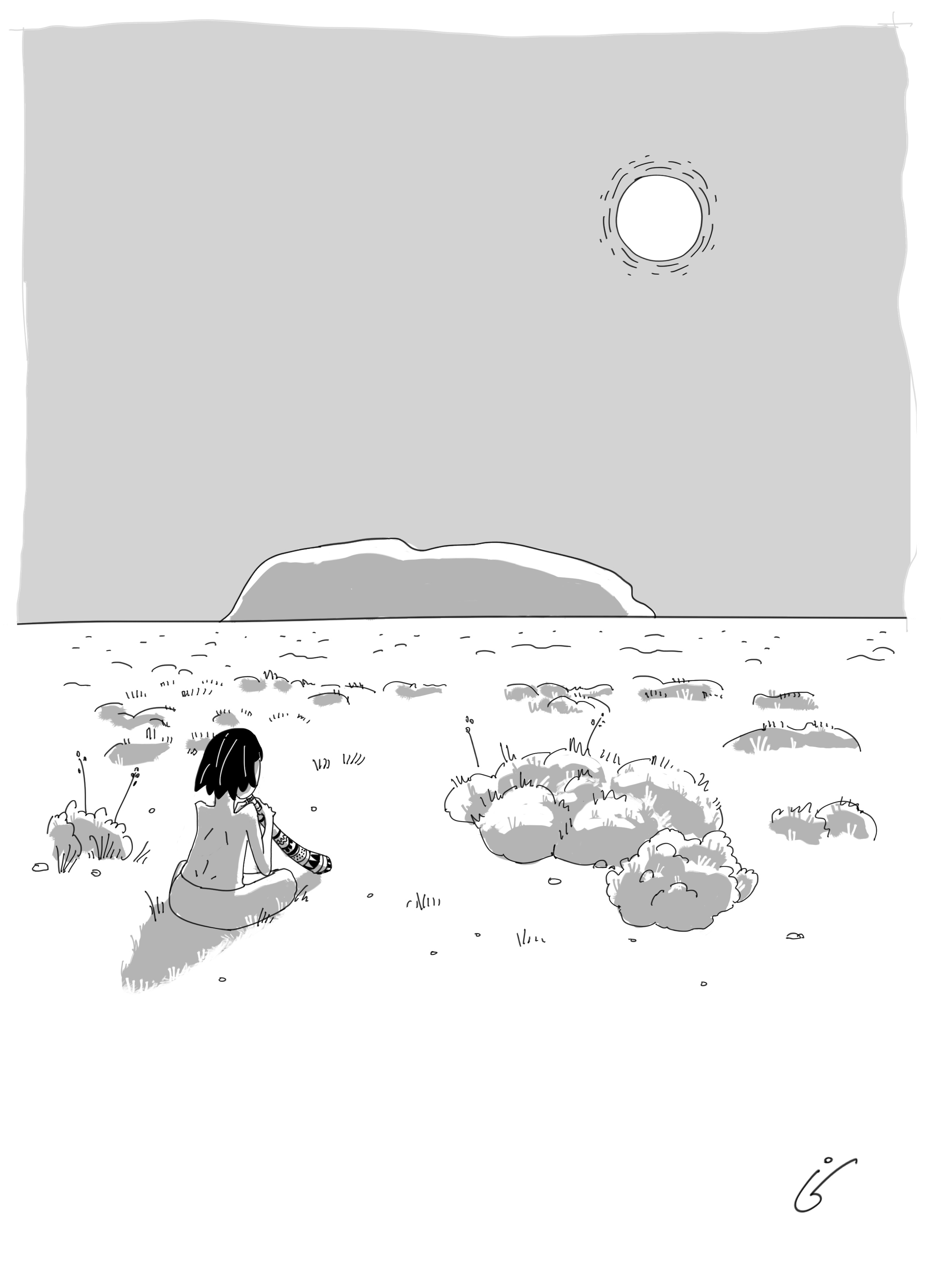
Imagine… Imagine, you have arrived at the antipodes, or almost, sixteen thousand three hundred kilometres from Mirecourt, the region of your mother’s family in France. You’ve dreamed about it for a long time, you are on the island-continent of the southern hemisphere which, together with Tasmania and other islands in the Pacific, Southern and Indian Oceans, covers most of Oceania. You are in the “Down Under” country: upside down! Strangely enough, you are here “at home”, without ever having set foot there. Everything is different, and the light reminds you of your childhood on an island in the Indian Ocean: you were born and raised in Reunion Island. Without noticing it, you walk… upside down! Australians also call their country “Aussie”: Australia, the adventure of the first men (1).
During the last Ice Age, when the sea level had fallen, the first settlers crossed the Torres Strait, boldly braving the uncertain waves and the unknown, towards an invisible continent. Ancestral groups apparently sailed from the islands of present-day Indonesia to reach the Sahul, the continental shelf formed by Australia, Tasmania and New Guinea. The Torres Strait Islanders lived in what is now northern Queensland, Australia. Together with the Aboriginal People they form one of the two sets of indigenous peoples of Australia, who are the direct descendants of the people who emigrated from Africa, the cradle of humanity. Daring the first great sea crossing in history, they were the first humans to migrate over such a distance, 70,000 to 125,000 years ago, according to the latest scientific estimates.
Imagine, you are not even twelve years old, you have just read “The Dreamtime” by Cyril Havecker and you make this journey to meet your many parents, uncles, aunties, cousins, nieces, nephews, gran uncles, gran ma… of all ages, and ancestors in pictures: great-gran-mother, great gran-aunty, gran-father, great gran-uncle. One of them is Zulu, another is British, a grandmother even lived until 107 years old!
During a twenty-three hour flight you saw the sun rise for the second time in the same day, just after the stopover in Singapore. Finally you flew over the Outback, as big as two thirds of Europe, for hours on board a Boeing 787. Behind the window your gaze wanders across a vast expanse of carmine red, golden sand, dotted with tufted grass of an earthy green and silvery colour, red sand as far as the eye can see, cut by wind-streaked dunes. Here and there bodies of water, billabongs, rocks and geological formations enigmatically draw Tjukurrpa -Tjukurrpa in the Anangu language (2) is what Westerners translate by the Dreamtime: a non-linear time that has nothing to do with the dreams that populate our sleep!
You can sense the power and strength of Tjukurrpa: painted, danced, sung, taught in a secretly guarded mimicry that rekindles the Creation of the world with the Great Ancestors. In a mysticism transmitted from generation to generation, it links each individual to their people, their tribe, their clan, their family, in order to consecrate them as guardians of Mother Earth, through an element of the fauna and flora for which they become personally responsible…
After overcoming the semi-arid bush, crossing fertile regions with lush forests, you land on the east coast of the main island of the Australian continent, in the seaside city that bears the name of its river, Brisbane. It is the capital of the state of Queensland on the edge of the Pacific Ocean. It is actually where your half-sister is, and you only know each other in pictures. A text message arrives at the airport: she’s on her way in with her mum, and she’ s wearing a red jacket!
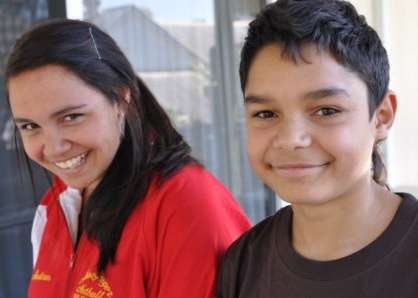
Imagine, you’ve just met your sister who’s two years older than you, her name is Madison Rose: “You are family”, “you are Aboriginal”, that’s what you’re hearing, that’s what you’re strangely feeling as well. The first day at dawn, you are pulled from your sleep by an incredible noise. KooKooKooKooKoo Ka Kakakaaa Kaaa Kaaa Kaiiii!!!! Your bewildered expression makes all the cousins at the table giggle with laughter. It was the laughter of the kookaburra, the bird alarm clock with its thunderous song so surprising, so familiar to all Australians.
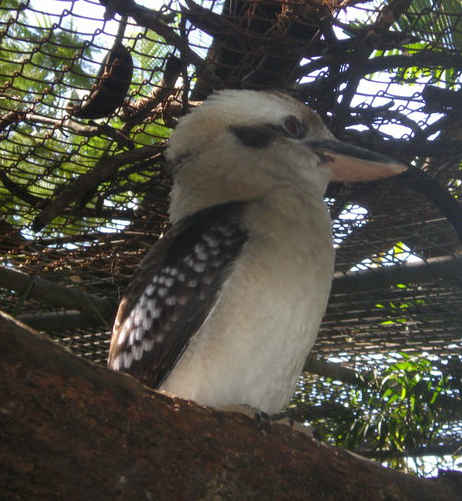
They laugh even more when you happily bite into a warm toast topped with margarine and Vegemite, which you mistake for chocolate spread - that salty marmalade made from bouillon cubes brought over by the British colonists makes you make hilarious faces. For your arrival, a corroboree has been organized: it is a traditional ceremony given in the language of the kamilaroy people who greet you with dances and songs. (3). Later on, you will be honored by a “Smoking Ceremony” organized for you to ensure the protection of your ancestors.
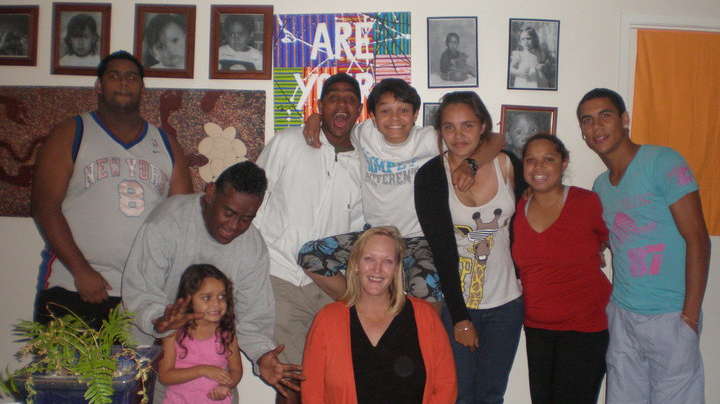
With Maddi at the koalas sanctuary, softer than a teddy bear, you discover one of them dozing with his legs clinging to the trunk of the eucalyptus tree, karri, where he falls asleep for up to twenty hours a day. Later on you establish a special connection with a wallaby that you hold in your arms! And here is the platypus, a true chimera from old legends, who defies the laws of biology with kindness… Among the many animals that populate the tales of countless aboriginal stories, here is the wombat coming out of its burrow, and the wild dog, warrigal, yellow dingo, introduced into the island four thousand years ago, and the emu, dhinawan, known for its ability to take care of its family, and then that outstanding miimc, the lyre-bird…!
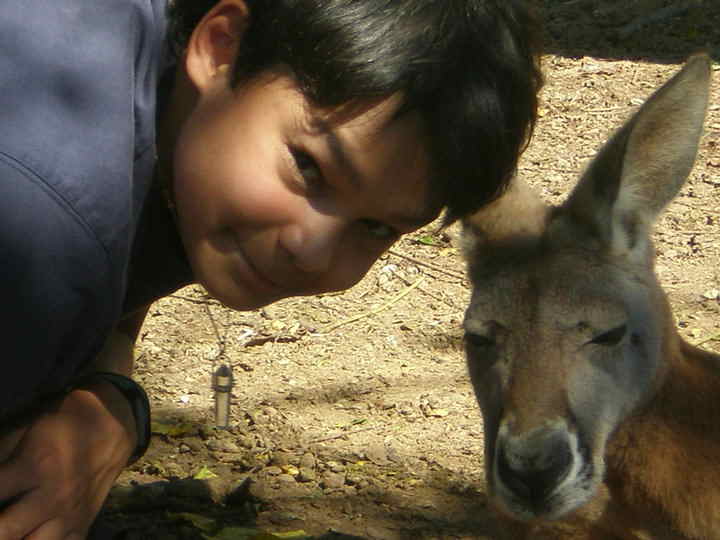
A few weeks later, you moved to the city of “Syd”. It’s the hip, trendy city, with its oversized buildings in New South Wales: Sydney, its familiar opossums that go out at night in the trees of the city, its artists on the famous circular quay: this is where you receive the white body paints, with your skin name: “Gilbinung”, and there too is revealed to you your totem, “Badagarang”. The large red kangaroo thus indicates your lineage in belonging to the Wiradjurris clan, one of the largest Aboriginal tribes in South Australia, among “the survivors of the disaster” (4) caused by Western colonization.
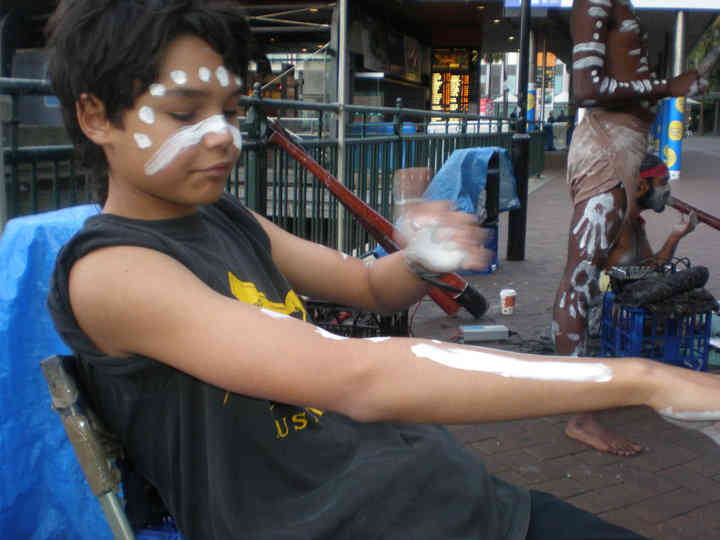
In a cyber-café, as a computer science enthusiast, you are introduced to the C language with the help of an online tutorial. To extend your stay for up to three months, your mum does housework in a backpacker’s hostel. This means you can join your grandmother in Wollongong, a coastal town south of Sydney: she will pick you up by ferry. In the huge Royal Botanic Garden, signs invite you to undo your shoes on the lawn to go and hug the trees. You play the didgeridoo for the cockatoos.

Those large white parrots with yellow crests come close to you curiously and make familiar faces. Some of them even perch on your shoulders. They seem to dance to the music. It must be said that when you were seven years old, in Reunion Island where you were born, between France and Australia, an Aboriginal dance company called “Descendance” landed there for the “Arc en Ciel” festival. What an omen! After being introduced on stage like a mystical prince, in an unsettling and foundational experience, you had received a cockatoo feather as a sign of rallying to your aboriginality: a tangible sign to find your father because he hadn’t received the letters sent to tell him of your existence - an extra energy to meet your family there on Mother Earth. And all of this eventually happened!
In addition to a fabulous and difficult story, you have just inherited a yidaki, the oldest wind instrument in the world, dug out by termites. Your uncle James brought it to you from the bush, a priceless gift: it is the bloodwood in which your father Alan Dargin (5) played for the last time in his life. It was in Camberra, the Australian capital, at the Ambassy Tent, this great symbol of Aboriginal resistance, and it was just after the historic speech of the Labour Prime Minister Kevin Rudd in 2008 (6): an unprecedented, national pardon for the cultural genocide, the stolen generation and the crimes perpetrated against the Aboriginal people of Australia and the indigenous people of Torres Straits.
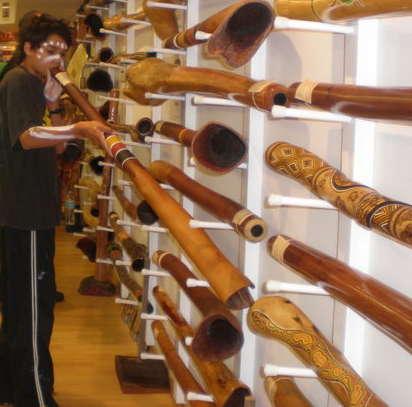
Just imagine. Arrived at your destination, you make another great journey, this time to the heart of the great continent, in the Red Center with its many deserts. You are in the Northern Territories, in the centre of mythical Australia. From Alice Springs in Arrernte land, you travel along part of the Mac Donnel Ranges, more than 600 km of mountains streaking the desert, to reach the ghostly town of Papunya by bus on a dusty track. Its very touristic cultural center employs many painters, in the north of the Luridja tribe.
All around you, ancient nomadic peoples like the Pintupi lives in community, where their ancestral painting has suddenly reached the heights of the world contemporary art market, offering artists a few extra dollars to survive the brutality of a radical change in lifestyle… Here the didgeridoo does not exist, as this traditional and cultural instrument is not played by all the Aboriginal peoples of Australia. You head further south and skirt around the huge, almost dry Amadeus salt lake, covered with a thick crust of shiny white salt, and you enter the Pitjantjatjara land.
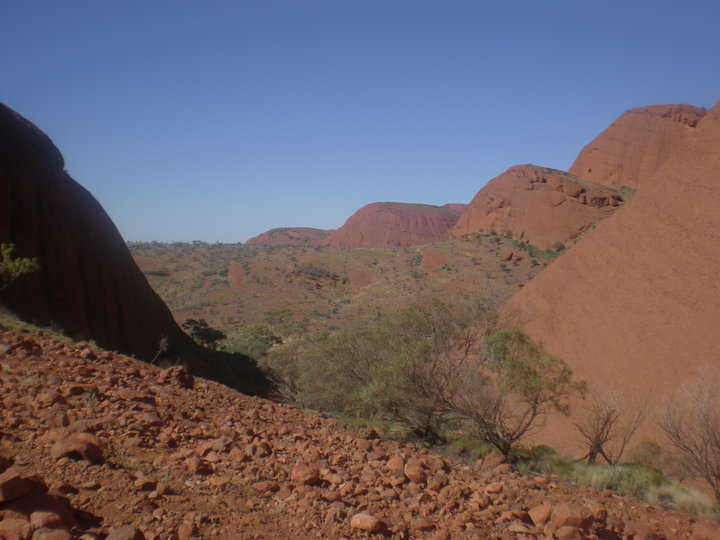
Behind your back, the Valley of the Winds, the Kata Tjuta mountains: thirty-six domes circle in the moonlight in the night-cooled outback. Around you, Gilbinung, the crickets whose name you bear rub their wings in a reassuring song. The spiniflexes still scratch your ankles and calves. A little earlier your boomarang wandered off into the blazing twilight of the sacred land, annihilated by greedy and indifferent drilling.(7)
It is almost midnight, and the night sky that your protecting ancestors deciphered tens of thousands of years before you, unfolds off the Southern Cross its Milky Way bordered by the Seven Sisters: the seven stars that make up the constellation of the Pleiades tells a story that is part of the many tales that nourish Aboriginal civilization.
Before you, Gilbinung, a tremendous magnetic presence. He is isolated in the middle of the desert, majestic, quite alive: it is the immense Uluru rock. “The rainbow snake Yurlungur sleeps in one of the basins on its summit” the Anangus say about It. The child from elsewhere doesn’t know it yet: Uluru can mean according to the context “the long sleep”, “protection”, “the journey” or even “freedom”. The famous rock is not the only sacred place on Aboriginal land: since time immemorial, many other places have secretly been passing songlines. Uluru is bathed by a big full moon with an opal light radiating from all the ochres of the desert plain. He asks the child to sit down, with no other witness than the whole Creation, magnified by Baiame. Gilbinung has just turned twelve years old and is finally at peace. Far from everyone, far from everything and quite easily, he plays: he plays for Uluru.
Marie-Pascale Gaudé
-
Australie, l’aventure des premiers Hommes[fr]. Documentary in two parts (“ les premiers pas des Aborigènes d’Australie “ : “this captivating work reveals the little known history of the oldest living civilization” Arte DVD store).
-
Before European colonization, there were many Aboriginal tribes and languages, about 500. Today, about 30 languages are said to be spoken by people whose aboriginal language is particular to their group and mother tongue. Other languages are spoken or known, but threaten to disappear. The notion of “aboriginal people” is therefore a western perspective. (Cf: Aboriginal Australian Map Although disputed, it is a reference).
-
At the end of the 18th century, at the arrival of the Europeans[fr], the Australian Aborigines numbered around one million inhabitants. Today, they are estimated to be about 265,000 people, around 1.6% of the total population.
-
“Ils sont les survivants du désastre” article by Barbara Glowczewski, Director of Research at the CNRS, anthropologist specializing in the Aboriginal people since 1979.
-
Pioneer musician "inventor of rock and roll didjeridu" and actor, Alan Dargin died of a stroke at the age of forty, on February 24, 2008. A few days before he was playing for the Sorry Day. Seven months earlier he came to Europe to meet his son Youva. Since 2015, a street is named after him in the Australian capital, Camberra. (cf "My son's father"[fr])
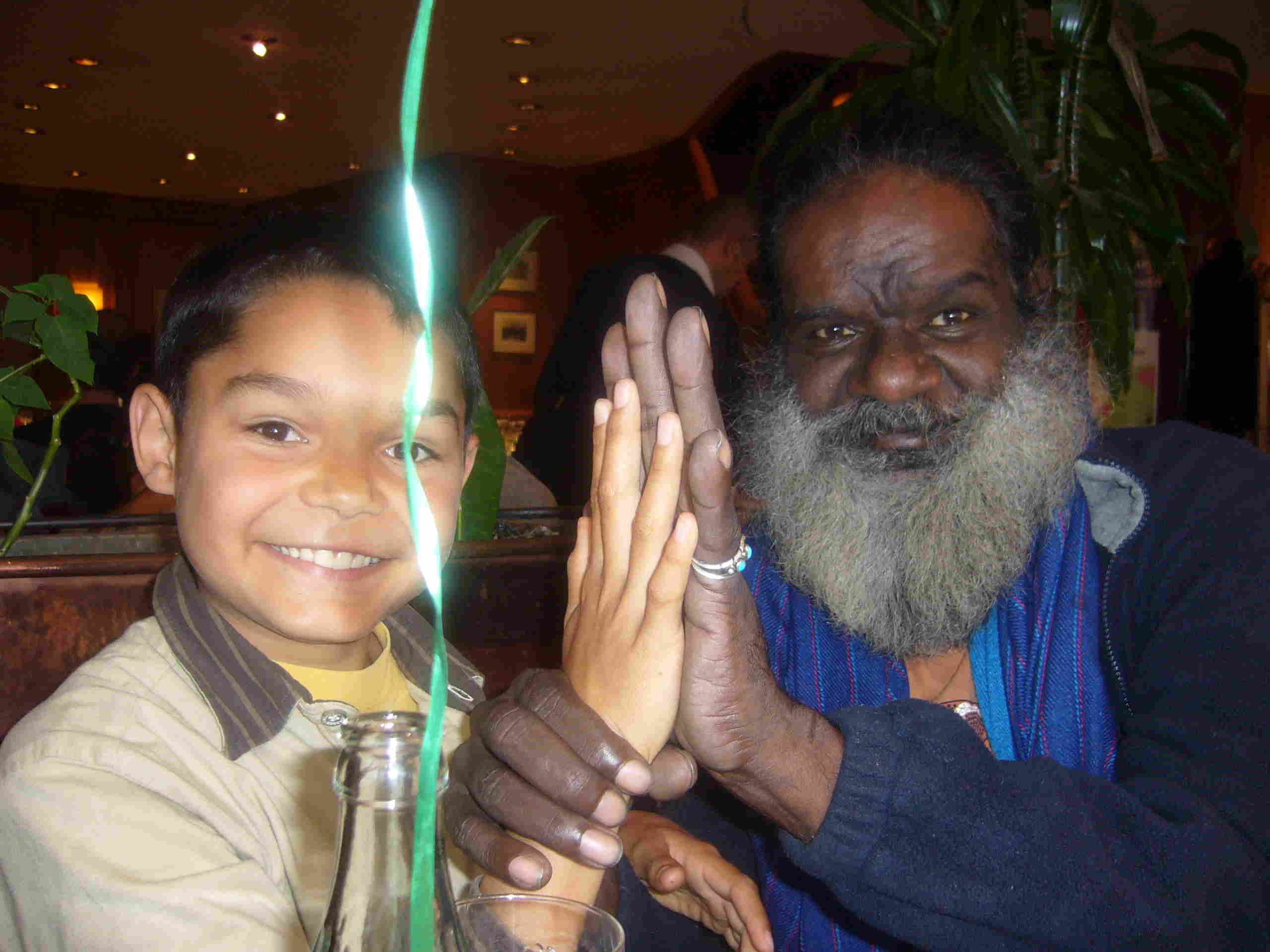
-
Kevin Rudd’s official speech on February 13, 2008[fr]: Australian government apology to the Aboriginal people - Survival International
- This contemporary tragedy of the over-exploitation of Mother Earth is fiercely fought by activists across the country and around the world - it was notably portrayed by the Aboriginal poet Kévin Gilbert[fr].
Special thanks:
- Alan Dargin (13-07-1967/ 14/02/2008), the artist and man of heart, and all of Youva’s paternal family: James Dargin, Liz Dargin and Helen, Fiona Frances Dargin, grand uncle Barry Ord, his family, and grand uncle Trevor… and the deceased uncle and grandmother (RIP)
- Alison Spearim, mother of Madison Rose Dargin, Youva’s half-sister, for their warm welcome.
- Her husband Paul Spearim, traditional culture teacher, for the organization of the smoking ceremony and the coroborree.
- Michael Baker, dancer (Lascaux Sessions, 2018), his partner Coco (RIP)
- Mikael Atherton, musician, ethnomusicologist
- Lisa Hogben, photojournalist
- Gumaroy Newman, songwriter, didgeridoo player
- Uncle Max on the cicular quay, the elder with the clap sticks
- Sherlock of the quay, artist (RIP) and his partner
- Richard Green, artist
- Janawirri Forest, artist, Doctor of Philosophy (his thesis) and his wife, a poet and librarian Jocelyn Freeman.
- Barbara Glowczewski, anthropologist specializing in the Aboriginal people (her profile on France Cuture[fr]).
- Lies Beijerinck, the “didge mama” in the Netherlands
- Gög multi-instrumentalist german musician
- Stephen Kent UK musician
- Willi Grimm, pioneer in Switzerland and Europe of the imported didgeridoo in 1971
- Djalu Gurruwiwi, an emblematic figure of traditional Australian music, from the Galpu Clan and the Yulgu people, met at the festival Le Rêve de l’Aborigène, as well as the elder Major Sumner, from the Ngarrindjeri language group, and the musician David Hudson for their friendship
- Lewis Burns, Wiradjurri painter and musician,
- Orgyen, monk at the Tibetan monastic center of Lusse[fr], in France.
- Father François-Marie Boucher, Rector of the Mattaincourt Basilica, and Jean-Pierre Vuillemin, Auxiliary Bishop of Metz
- Youva’s maternal family, his nephew Leopold and Matthias.
- Youva Gaudé for the inspiration and for the English translation of the short story Uluru Full Moon.